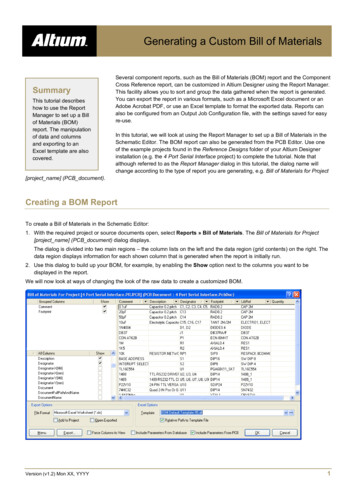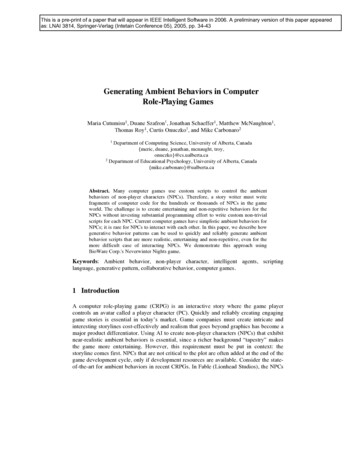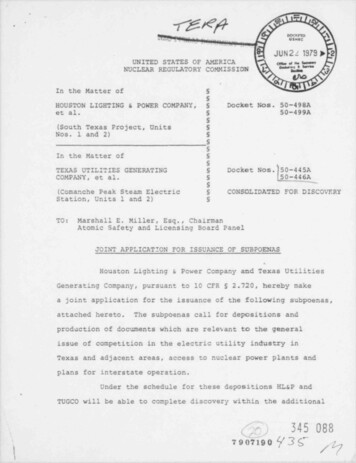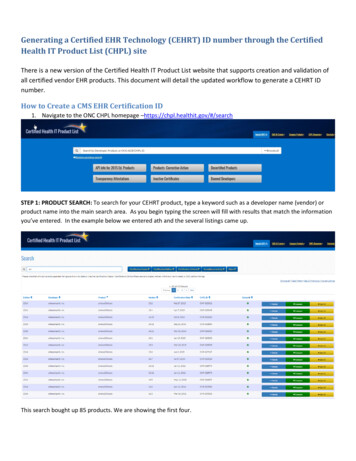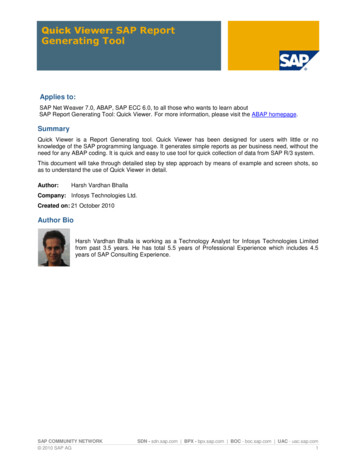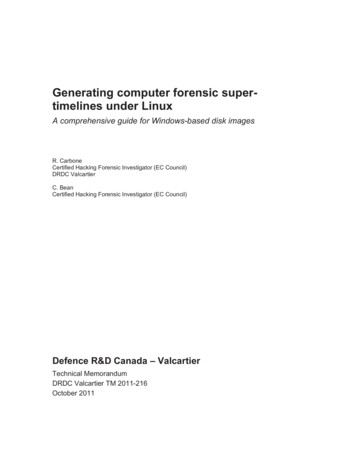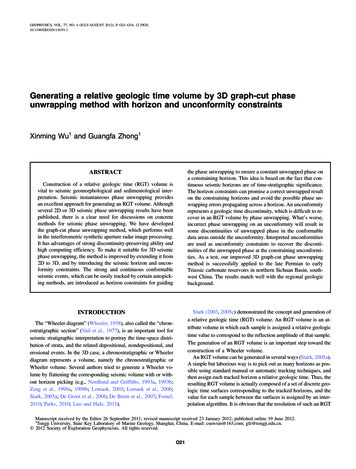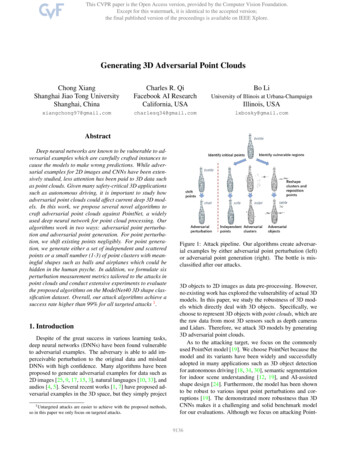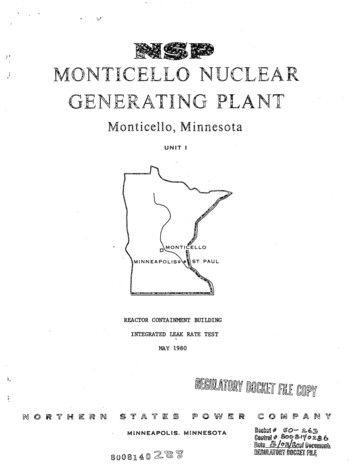
Transcription
MONTICELLO NUCLEARGENERATING PLANTMonticello, MinnesotaUNIT IREACTOR CONTAINMENT BUILDINGINTEGRATED LEAK RATE TESTMAY 1980RMEfA TUDO 1E copyMINNEAPOLIS,#MINNESOTAComtrolgo-Scafg443
NORTHERN STATES POWER COMPANYMONTICELLO NUCLEAR GENERATING PLANTREPORT TO THEUNITED STATES NUCLEAR REGULATORY COMMISSIONDIVISION OF NUCLEAR REACTOR REGULATIONLICENSE NO. DPR-22REACTOR PRIMARY CONTAINMENTINTEGRATED LEAK RATE TESTMAY 1980Report Date:August 8, 1980Report Prepared by:R. A. GoransonTest Conducted by:R. A. GoransonS. G. WhitsonC. F. NierodeREGULATORY DOCKET FILE COPY/
-ii-PAGETABLE OF CONTENTS1.1.11.2Purpose of Containment Leakage TestsTesting Requirements1.2.11.2.21.2.32.Type A Test ResultsType B and Type C Test ResultsType A Test Procedure3.1.13.1.23.2Type A Test Instruments and EquipmentType A Test Summary of EventsType B and Type C Test ProcedureSummary of Test Calculations4.1Type A Test Calculations4.1.14.1.2Calculation of ParametersCalculation of Containment Leak Rate12223333456667Point to Point MethodTotal Time MethodMass Plot Method7784.2Calculations for Verification of Type A Test Accuracy94.3Type B and Type C Test Description of Test Procedures3.14.Frequency of TestTest Acceptance CriteriaRequired Procedure for Leakage TestingTest Results2.12.23.1IntroductionPressure Decay Method CalculationsRotameter Method CalculationsError Analysis5.15.2101010Type A Test Error AnalysisType B and Type C Test Error Analysis1011Pressure Decay Method ErrorRotameter Method ErrorLeak Rate Monitor Method Error1112125.2.15.2.25.2.3
-111PAGETABLE OF CONTENTS (Cont'd.)FIGURE 1 Cross Section of Containment Vessel13FIGURE 2Installation of Pressure Gauges14FIGURE 3Containment Pressurization Flow Diagram15TABLE 11980 LLRT Summary16TABLE 21978 LLRT Summary17TABLE 3LLRT's Between Outages .1977-TABLE 4RTD's and Dewcells - DW & Torus19TABLE 5Test Instrument Data201978 - 198018APPENDIX AType B and Type C Test Data and Results1980 and 197821APPENDIX BSummary Report of All Type C Tests Failingto Meet the Leakage Acceptance Criteria1980 and 197831APPENDIX CType A Test Data and Calculations34APPENDIX DType A Test Verification Data andCalculations36
- 1 -1.Introduction1.1. Purpose of Containment Leakage TestsAs stated in 10CFR50, Appendix J, primary containment leakage testsare conducted to assure that:a) Leakage through the primary reactor containment and systems andcomponents penetrating primary containment shall not exceedallowable leakage rate values as specified in the TechnicalSpecifications or associated Bases.b) Periodic surveillance of reactor containment penetrations andisolation valves is performed so that proper maintenance andrepairs are made during the service life of the containment, andsystems and components penetrating primary containment.Results of containment leakage tests are reported to the Director ofNuclear Reactor Regulation, USNRC, following each periodic containment integrated leakage test (Type A test). This report must include:a) Analysis and interpretation of the Type A test results.b)Summary of containment penetration local leakage tests (Type Btests) and containment isolation valve local leakage tests (TypeC tests) conducted since the last Type A test.c) Separate accompadying summary report of Types A, B and C testswhich failed the acceptance criteria.1.2Testing Requirements1.2.1Frequency of TestingType A tests are scheduled in accordance with Paragraph4.7.A.2.a of the Monticello Technical Specifications. ThreeType A Overall Integrated Containment Leakage Rate Tests shallbe conducted at 40 10 month intervals during shutdown at Pa(41 psig) during each 10-year service period. The third testof each set shall be conducted during the shutdown for the10-year plant inservice inspection*.* The third test of the first 10-year service period shall beconducted during the 1980 refueling shutdown.If any periodic Type A test fails to meet 0.75 La the testschedule for subsequent Type A tests shall be reviewed andapproved by the Commission. If two consecutive Type A testsfail to meet 0.75 L , a Type A test shall be performed atleast every 18 monts until two consecutive Type A tests meet0.75 La, at which time the above schedule may be.resumed.
- 2 -1.2.2Test Acceptance CriteriaThe acceptance criteria for Type A tests is contained inParagraph 4.7.A.2.b(2) of-the Monticello Technical Specifications. The allowable operational leak rate, Lto, is 0.9weight percent of the contained air per 24 hours at Pt 41psig. The containment leak rate, either as measured or following repairs and retesting, must be less than Lto prior toresumption of power operation.The acceptance criteria for Type B and Type C tests arecontained in Paragraph 4.7.A.2(f). The allowable leakagerates are:1.2.3a) Double-gasketed sealsTotal Leakage34.4 scfh (10% L to)@ 41 psigb) Testable penetrationsand isolation valvesexcept main steamisolation valves103.2 scfh total (30% L to)17.2 scfh each ( 5% Lto)@ 41 psigc) Main steam isolationvalves11.5 scfh each @ 25 psigRequired Procedure for Leakage TestAll containment leakage tests were conducted in accordancewith 10CFR50, Appendix J and American National StandardANSI N45.4 - 1972, "Leakage - Rate Testing of ContainmentStructures for Nuclear Reactors".2.0Test Results2.1Type A Test ResultsThe primary containment integrated leak rate test (ILRT) wasconducted from May 6 through.May 8, 1980. The as left leakage wasdetermined by the mass plot and total time analytical methods. Theleakage rate, as determined by the mass plot method, was 0.6324 0.0295 wt. %/day. The total time method leakage for the interval ofthe test was 0.6184 wt. %/day. The error analysis was done at a 95%confidence level. The leakage is within the Technical Specificationacceptance criterion of 0.90 wt. %/day. The data and leak ratecalculations for the test are tabulated in Appendix C.The measured combined leakage rate during the verification test was1.0063 0.0533 wt. %/day. The predicted combined leakage was 1.2498wt. %/day. This comparison is well within the required accuracyprescribed in 10CFR50, Appendix J. The data and leak rate calculations for the verification test are tabulated in Appendix D.
- 3 -It is noted that an ILRT was conducted from March 29 through March31, 1980, at the end of a refueling outage. The verification testresults were not acceptable to Region III, USNRC, therefore the testwas repeated in May, 1980.2.2Type B and Type C Test ResultsDuring February, March and April, 1980, local leak rate tests wereconducted onall testable penetrations, double-gasketed seals, doorsand isolation valves. Results of all tests are tabulated inAppendix A and summarized in Table 1.During the refueling outage in 1978, from October through November1978, local leak rate tests were conducted on all testable penetrations, double-gasketed seals, doors and isolation valves. Results ofall tests are tabulated in Appendix A and summarized in Table 2.A separate summary report of all Type C tests which failed to meetthe leakage acceptance criteria of the Technical Specifications and adiscussion of the repairs accomplished is included in Appendix B.All isolation valves with leakage in excess of the individual valveleakage limit were restored to acceptable leak tightness. Totalleakage for double-gasketed seals and total leakage for all otherpenetrations and isolation valves following repairs satisfied theTechnical Specification limits.A summary of the Type B and Type C tests that were performed sincethe last Type A test in November 1977 and the 1978 refueling outageand from the 1978 refueling outage to 1980 refueling outage isincluded in Table 3.3.Description of Test Procedures3.1Type A Test Procedures3.1.1Type A Test Instruments and EquipmentThe ILRT was conducted using the absolute method as specifiedin ANSI N45.4-1972 and where possible and practicable, therequirements of ANS N274 (draft) were also used. The principlemeasuring instruments consisted of 20 Rosemount Engineeringtemperature transducers with platinum resistance temperaturesensors, five Foxboro dewcells and two Validyne pressuretransducers.Rosemount Model 442A ALPHALINE Temperature Transmitters wereplaced throughout the containment to monitor temperature. Thetemperature sensing system consisted of twenty individual2-wire temperature transmitters each connected to a platinumresistance temperature sensor and a regulated DC power supply.Each resistance temperature detector was assigned a weightingfactor proportional to the volume monitored for use in calculating the average containment temperature. Table 4 lists the
-4 -resistance temperature detector locations and assigned weighting factors. The RTD signals were transmitted to the plantprocess computer where a ten minute average of the temperatureat each locale was printed by the computer typer in degrees F.Foxboro Model 2701 RPG dewcels were used to monitor containmentvapor pressure. Each dewcel was assigned a weighting factorproportional to the containment volume monitored for calculation of average vapor pressure. Table 4 lists the dewcellocations and assigned weighting factors. The dewcel signalswere transmitted to the plant process computer viaresistance-to-current converters and a ten minute average ofthe vapor pressure at each locale was printed in inches ofwater by the computer typer. Reading the dewcel resistanceand conversion to vapor pressure was accomplished by enteringthe required calibration curves into the computer memory.The Validyne pressure transducers together with carrierdemodulators, power modules and digital readout using aFairchild multimeter were used to indicate the containmentpressure. These instruments were redundant to each other withone designated as the primary and the other the secondary. AWallace Tiernam, Model 1500 pressure gauge was used as additionredundancy to the pressure transducers.Additional data on the-integrated leakage rate instruments aresummarized in Table 5.The containment was pressurized using two 1400 cfm and one1200 cfm portable diesel air compressors (Figure 3). The airwas temperature controlled using a containment pressurizationequipment skid. The air was supplied and metered to thedrywell through a flange connection on the nitrogen purgesystem.3.1.2Containment ventilation was provided by a two-speed drywellventilation fan operating at low speed and six portable 10,000cfm electric fans equipped with.oversized motors to promotemixing of the air.Type A Test Summary of EventsThe pre-test containment inspection was completed on May 5thwith no visible structural deterioration found. Majorpreliminary steps were completed and included:a)Installation of portable electric fans in the containment.b)Final check-out of temperature and humidity instruments.c)Replacement of all manway covers followed by Type B tests.
- 5 -d)Blocking of all vacuum breakers in the open position.e)Valving out of all drywell pressure switches.f)Jumpering of all reactor water LOW level switches.g)Draining of the reactor vessel below steam and feedwaternozzles.h).Draining of steam and feedwater lines.i)Venting of reactor vessel to containment atmosphere.j)Completion of valve lineup sheets.k)Isolation of the drywell instrument air system and ventingof the main steam isolation valve and safety/ relief valveair accumulators.On May 6 at 1840 all preliminary steps had been completed, thecontainment.had been closed and permission was given.to commencepressurization. At 1849 pressurization commenced at a rateslightly greater than 11 psi per hour. At 2235 on May 6, thecompressors were shutdown at an indicated containment pressureof 42 psig.During the four hour temperature stabilization period, datawas logged at 20 minute intervals with the initial data pointat 2300 on May 6. Temperature stabilization was confirmed andthe initial test data point was established at 0300, May 7.At 1120 on May 7, sufficient data had been collected and theILRT was considered complete.The verification test controlled bleed was established at1130, May 7 and the first data point of the verification wastaken at 1140 with data points taken every 20 minutes, asbefore. At 1640 sufficient data had been collected to verifythe accuracy of the ILRT within the allowable accuracy delineated in 10CFR50, Appendix J and ANS N274.The containment was depressurized through the torus 2-inch and18-inch vent lines to the Standby Gas Treatment System. Thecontainment depressurization was completed at 0355, May 8.The containment was subsequently inspected and no damage wasdiscovered.3.2Type B and Type C Test ProcedureAll tests were conducted with air or nitrogen using the pressuredecay or rotameter methods or a local leak rate monitor. The leakrate monitor was manufactured by Volumetrics, Inc., of Inglewood,California. The rotameter method was also used to estimate grossleakages. The test volume (between redundant isolation valves, the
- 6 -center of double-gasketed seals, or the volume of'an electricalpenetration or hot fluid pipe penetration expansion bellows) waspressurized slightly above test pressure. Conditions were allowed tostabilize and the leakage rate was measured. In tests using thepressure decay method, the decay rate at Pt was obtained from thetest data and used in conjunction with the known test volume tocalculate the leakage rate. Temperature corrections were not madebecause of the difficulty of positioning a temperature sensor in thetest volume. In addition, it has been demontrated in the local leakrate error analysis that these corrections are small compared toother uncertainties in the testing procedure. Rotameter tests werevented to the atmosphere. Temperature and pressure corrections weremade based upon rotameter calibration. In tests using the leak ratemonitor, the test volume is pressurized and the pressure maintainedby a precision regulator. The flow rate required to maintain the setpressure is measured by a mass flow transducer and displayed indigital form in units of standard cubic feet per hour.Isolation valves were tested either singly or several in the sameline were tested simultaneously depending upon the location of theinstalled'test connections. Nitrogen was used to test all electricalpenetrations.4.Summary of Test Calculations4.1Type A Test CalculationsEach 20 minutes during the integrated containment leak rate test andduring the controlled bleed verification test, the following calculations were made to determine the leak rate by the point to point,total time and mass plot methods. In addition, calculations weredone for the 95% confidence interval for the results from each of themethods.4.1.1Calculation of Parametersa)Containment Absolute Pressure (psia) PBARLocal Barometric Pressure (psia)PBAR . PI-1b)PI-1 Drywell Pressure Transducer (psig)Containment Average Temperature (oR)i 20T IW.T. 459.72i 1W. Weighting factor for RTD. from (Table 4)T. Computer reading of RTD.1 (oF)11Cp1
- 7 -Containment Average Vapor Pressurec)WEIGHTED AVERAGE CONTAINMENT VAPOR PRESSURE (incheswater)i 6PVi 1W .P.v viW . Weighting factor for dewcel i (Table 4)P . Computer reading (inches water) for dewcel iVi4.1.2 Calculation of Containment Leak RateNomenclature for all equations is the same.as follows:P P.vThese symbols areContainment absolute pressure Containment weighted average vapor pressureT Containment weighted average absolute temperatureH Total time since start of testSubscript 1. initial pointSubscript i i th point4.1.2.1Point to Point MethodCorrected for Vapor Pressure% Leakage (wt %/day) 4.1.2.2[1i (PTi(P 1- Pvi-1)24 0HTotal Time MethodCorrected for Vapor PressureT (P -P% Leakage (Wt %/day)1)2400H
- 8 -4.1.2.3Mass Plot.MethodCorrected for Vapor Pressure144 (P -P1v,1RT1W1, Where:VW Weight of air in the containmentV Free air volume of containment 247,353 cubic feetRGas constant for air 53.35 ft lblb oRmThe leakage rate is determined from the above calculationsof the mass of air (W.) at each time point i by applyinga linear regression analysis to the data. A linearregression analysis consists of minimizing the squaresof the deviations of the data points from a straightline:W At BThe slope (A) and the intercept (B) of the line arecalculated as follows (all summations are from i - 1to n).A (U t.7W.)/n]It.W.i i2Ift1.B - IW.nWhere:i1 2I.n-iAlt.nt time since the initial data point.The leakage rate in weight percent'per day is:% Leakage (wt %/day) (-A) (2400)BThe twenty minute readings and calculations were usedto construct a plot of leakage rates versus time(Figure C-1). This plot was useful for detectingtrends of possible anomalies. The containment leakagerate was taken as the mass plot method calculatedleakage for the test period. The results of the totaltime method leakage for the test period compare favorably
- 9 -with the results from the mass plot method. All dataand calculated leakages for the integrated leak ratetest are tabulated in Appendix C.4.2Calculations for Verification of Type A Test AccuracyFive hours of useful data were taken with a controlled leak rateestablished in addition to the normal containment leak rate. Thesuperimposed leak verification test acceptability was demonstratedusing the criterion from ANS N274. Acceptability is proven if:(L LoamWhere: LLamcL0.25 L ) L-t c (L.o Lam 0,25 Lt)measured containment leak rate measured containment leak rate with superimposed leak maximum allowable leak rateL0 1.2 wt %/daysuperimposed leak rateThe superimposed leak rate was required to be between 50 and 100 percent of L . Throttle valve R (Figure 1) was opened and adjusted toprovide the superimposed leak. Rotameter indication and actual bleedrate are related in the following equation:14.40 mint (14.7)(W %/24-hour) VcP(100%)daycF Rotameter indicated flow ratef (Absolute Pressure at Rotameter Discharge During Test)(Absolute Pressure at Rotameter Discharge When Calibrated)1/2P Average Containment Absolute PressureDuring Controlled BleedV c Containment Free Air Volumeft 3247,353 ft(Absolute Temperature at Rotameter Discharge When Calibrated)(Absolute Temperature at Rotameter Discharge During Test)The superimposed leakage rate (L ) was calculated to be 0.6264 Wt%/day.The test verification criterion were met. Data and calculations forthe verification phase of the integrated leak rate test are tabulatedin Appendix D.1/2
-4.310-Type B and Type C Calculations4.3.1Pressure Decay Method CalculationsThe Type B and C local leak rate test calculations made usingthe pressure decay method are as reported in the summarytechnical report submitted August 3, 1973 entitled "ReactorContainment.Building Integrated Leak Test - May 1973".4.3.2Rotameter Method CalculationsThe Type B and C local leak rate test calculations made usingthe rotameter method.are as reported in the summary technicalreport submitted January 23, 1976, titled, "Reactor ContainmentBuilding Integrated Leak Test - November, 1975.5.Error Analysis5.1Type A Test Error AnalysisAs reported in "Supplement No. 1 to Report of Reactor ContainmentBuilding Integrated Leak Test - November, 1975," submitted March 16,1976, the error analysis method used was a standard statisticalT-distribution error calculation. As further reported in the abovementioned supplement, the instrument error analysis previouslyperformed would be referenced in future test reports unless changesin the test instrumentation required a revised analysis. The use ofthe absolute method of testing and the instrumentation changes madefor the test cause a revised analysis to.be submitted.As was done previously,' the instrument error analysis will bereferenced in future tests unless changes in-the test instrumentationrequire a revised analysis.The following instrument error analysis was done in accordance withANS N274, Draft 3, Appendix G, Instrumentation Selection Guide. Allsymbols are as used in above reference.222.1/22.v. 22
The Validyne pressure transducers together with carrier demodulators, power modules and digital readout using a Fairchild multimeter were used to indicate the containment pressure. These instruments were redundant to each other with one

